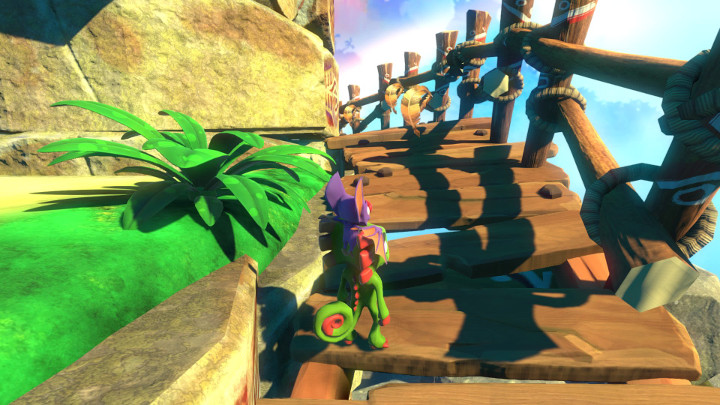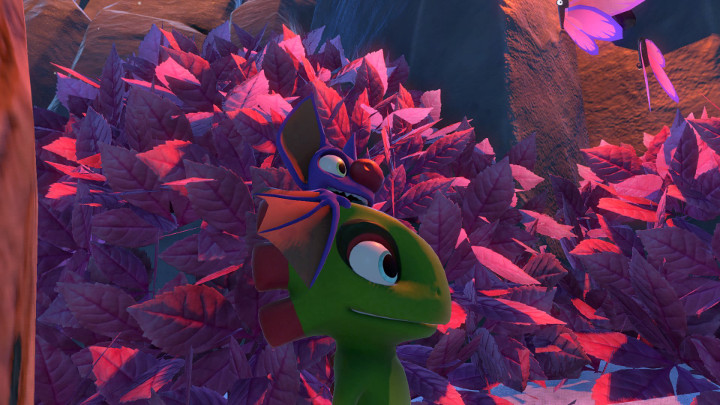
With Yooka-Laylee, developer Playtonic doesn’t re-invent the wheel so much as de-invent it. And this is perfectly okay. The game’s goal was never to push gaming in a radical new direction, but to remind us of a time when 3D video games were still precariously trying to find their footing.
The 1990s saw the rise of the 3D mascot collect-a-thon platformer — with games like Mario 64 and Banjo-Kazooie — and Yooka-Laylee was intentionally created to bring back that vibe (which makes sense, since much of Playtonic’s staff once worked for Rare, the developer behind Banjo-Kazooie and so many other incredible games).
In some cases, this causes joyful synapses to fire in the nostalgia centers in our brains, and these moments are when the game shines brightest. On the other hand, there are instances in which Yooka-Laylee‘s 1990s sensibilities cause it to become a chore. What may have been an acceptable flaw back in 1998 has become a buzzkill for those of us trying to huff the intoxicating fumes of our vicarious childhood memories.
So Yooka-Laylee‘s 1990s design ends up being a double-edged sword.
Let’s start with the good.
Oh, so much charm

Yooka-Laylee is all slathered up with charm. The characters have quirky little personalities, and they speak to one another in hilarious non-languages filled with grunts and random vowel sounds. And, come on, there’s a snake named Trowzers.
While there’s a sinister bad guy somewhere in the mix, you get the feeling from the very beginning of the game that things are going to be just fine in the end, and whatever danger there is in this world is very rarely clear or present.
This is undeniably a return to the era of the 3D mascot platformer, an era that witnessed the origins of Crash Bandicoot, Spyro the Dragon, Banjo and Kazooie, and so many more of these charming little guys. Yooka and Laylee are in good company — no, the best company.
An amazing color palette

Not all that long ago, there was a time when video games fell into a bit of a slump, dominated by a genre that was often referred to as “the brown-and-gray shooter.” We’ve since moved on, and current games no longer struggle to distinguish themselves among an overwhelming soup of drab, muted colors, but Yooka-Laylee takes the whole color thing into overdrive. Even its darkest spaces are bright and cheerful, and there are spaces where you can tell the designers threw in some extra colors just because.
Back in the 1990s, games like Crash Bandicoot and Mario 64 drew us in with backdrops bursting in color despite their low-fidelity limitations. Going back to that design mentality feels really good.
Races for no reason

While later Mario games would build on the formula, Mario 64 featured inexplicable races against creatures who just wanted to see Mario exercise his speedy little legs. Yooka-Laylee brings this back, and it’s glorious. It doesn’t matter that the rules of these races defy the rules of human society — when was the last time a figure approached you on the street and randomly challenged you to a footrace? — yet in the video game world, this actually presents a great challenge.
The sound it makes when you collect a Quill

Quills are the game’s main form of currency, and if you can chase down your good buddy Trowzers, you can spend these Quills on new moves that will often help you get into new places. Every time you collect a Quill, there’s this sound that I can only explain as late-1990s video game sensibilities distilled into a single piece of audio. It’s this muted harp tone that kind of sounds like it’s being played on a Casio keyboard. Every time I hear it, my brain tries to tell me I’m playing a PC role-playing game from the 1990s.
This is just one of many design choices that proves Playtonic knows exactly how to conjure up those long-dormant memories of late-90s game-dom.
Gaudy font choices

Nothing says 1990s design like gratuitously gaudy fonts, and Yooka-Laylee nails that look without being obnoxious about it. I don’t know what else to say besides just look at that logo.
Bad puns

I guess this is part of the game’s charm, which I’ve already touched upon, but Yooka-Laylee is full of bad puns and semi-inoffensive toilet jokes. In fact, you talk to every character in the game, you’ll never be too far way with some random silliness. It’s hard to get too mad at a game that’s so willing to partake in this level of wholehearted goofball shenanigans.
Unfortunately, Yooka-Laylee also brought along some flaws when it time-travelled from the 1990s.
Unskippable cutscenes

In between levels, Yooka-Laylee features excruciatingly long, unskippable cutscenes. To make matters worse, the text speed is maddeningly slow. Sure, these scenes can be cute and charming and all that, but it would be nice to just jump into a game about a lizard and a bat without having to sit through a story intro or random cutscenes after each level. I have a feeling that had we been given the option, a vast majority of players would have skipped right past all this to get to the good stuff.
Constant fighting with the camera

Navigating the open spaces in Yooka-Laylee is just fine. But whenever you get into a narrow area the camera flies off whatever it’s mounted to and lodges itself into a tree or a wall until some cameraman wrestles it down. In Yooka-Laylee, you must control this cameraman on top of having to already control both Yooka and Laylee.
The beginning of the 3D era of video games was one in which camera control was a persistent problem, but we’ve since moved on. Bringing back the unwieldy camera angles of the 1990s doesn’t stir up nostalgia as much as it stirs up whatever you’ve recently eaten. I’m not joking when I say that this game often makes me nauseous, and that’s something I’ve not experienced from a video game in a long time (VR excluded, of course).
3D platforming

After Mario 64 blew everyone’s mind, 3D platforming experienced a short-lived boon. In fact, 3D platforming was making its way uninvited into several game genres, including the first-person shooter. The trend ultimately died out because it was perpetually responsible for creating frustrating game moments in which you’d try to jump onto a platform, only to misjudge the space because floating platforms don’t translate all that well to 3D environments displayed on 2D screens.
Yooka-Laylee unashamedly brings back 3D platforming across floating, moving platforms. It’s not quite as bad as, say, Bubsy 3D or anything, but it can get a little annoying.
Sloppy controls

Yooka-Laylee‘s controls could definitely be improved upon. They’re sloppy and floaty, and when the camera tends to move around on its own, trying to simply jump straight ahead can be exercise in futility.
The game’s first boss fight, Great Rampo, is an excellent example of when this can go really wrong. The fight has you perform a Reptile Roll up a long ramp while Rampo sends a barrage of rolling logs at you. This shouldn’t be all that difficult, because the logs come down in easily discernable patterns, but subtle movements while in Reptile Roll mode are next to impossible. You’ll constantly be overcorrecting and thrusting yourself into danger on the opposite side of the ramp unless you’re able to nudge the thumbstick ever-so-gently.
Then, when you approach the top of the ramp, it’s sort of a crapshoot if you’re going to end up on top of the boss platform or not. Sometimes, you just can’t make the jump for no discernable reason. Other times, you overshoot into the thorn bushes at the edges. And other times still, you’ll make the jump only to be knocked back by Rampo’s fire breath.
This whole scenario should actually be pretty easy. It doesn’t sound tough on paper, and it wouldn’t be for any character with a good control scheme. Mario would make these jumps with his eyes closed while simultaneously knitting a scarf and drinking a hot cocoa. Yooka and Laylee, on the other hand, can’t seem to coordinate well enough to make it work, and that’s a problem that will turn many of the game’s seemingly simple obstacles into controller-tossing, four-letter-word-spewing moments of sheer madness.
Janky loading screens

Yooka-Laylee‘s loading screens are absurdly 90s in kind of a good way. But the downside is that they tend to freeze up — on the PS4, at least — long enough that you might consider hitting reset. Seriously, the first time I encountered a loading screen, I thought I’d broken the game.
Yooka-Laylee manages to wholeheartedly capture the spirit of late-1990s game design, but with this comes a lot of old frustrations that the gaming scene has since left in the rearview mirror. With a few tweaks, the Yooka-Laylee formula could really shine in the current gaming climate. If Playtonic can create a sequel that addresses the issues I’ve mentioned above, they’ll be well on their way to reestablishing the 3D collect-a-thon platformer in a huge and exciting way.
